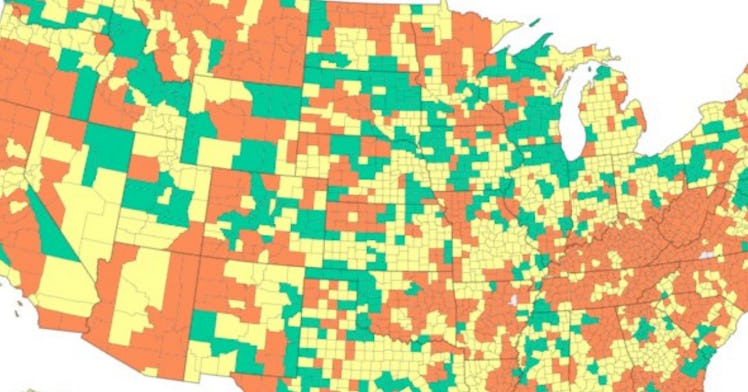The CDC’s New Mask Rules Are Confusing. This Tool Makes It Easy.
An easy-to-read interactive tool can help you decide whether you should mask based on where you live.

If you’re struggling to keep up with the ever-changing health recommendations two years into the pandemic, you’re not alone. Just last week. on Friday, February 25th, the Centers for Disease Control and Prevention (CDC) has eased federal mask guidelines for most of the country by creating a new metric for COVID-19 risk. While these are just recommendations — and do not replace, say, a statewide mask order, they are still guidelines for calculating your risk level if you decide to, say, walk into a grocery store maskless.
If you found the CDC news confusing, and you’re not sure if where you live means you should wear a mask or not, the CDC launched a tool that takes all the confusion away in just a handful of clicks.
The New CDC Guidelines, Explained
Former CDC guidelines stated that masks were recommended in communities where there was a high risk of COVID-19 transmission. During the peak times of the pandemic, that meant approximately 99 percent of people in the U.S were recommended to wear masks.
But now, those metrics have shifted. Instead of recommendations being based on transmission numbers, the new recommendations for when to wear a mask will be based on not only new cases but also hospitalizations due to COVID and hospital capacity. Essentially, masks will now only be recommended in regions of the country that have been significantly hit by severe cases. But, if you’re a regular busy person going through your life, you might not know if that’s you offhand as state and local mask mandates begin to ease.
If you live in an area marked “high risk” the agency recommends mask-wearing, staying up to date with your vaccines, getting tested if you have symptoms, and taking potential additional precautions if you are at high risk of severe illness.
If you live in an area with a “medium” level risk, the agency recommends speaking with your care provider on whether you should wear a mask if you’re at high risk of severe illness, staying up to date with your COVID-19 vaccines, and getting tested if you have symptoms.
If you live in an area with “low risk” the agency only recommends that you, yes, stay up to date with your vaccines, get tested if you feel sick, but doesn’t recommend the use of masks.
This CDC Tool Can Help You Figure Out If You’re At “Low,” “Medium,” or “High” Risk Quickly
The CDC has issued a new tool to help communities quickly understand if masks should be worn in their area based on the most up-to-date data.
The map allows you to search by your state and county to learn whether or not you are in a low, medium, or high-risk area. Since under new CDC guidelines, if you’re in a low or medium risk area, you aren’t necessarily recommended to mask, it’s great information to be able to suss out in just a minute before you head out the door that day.
For example, if you live in Barbour County, Alabama, the tool tells you you are at high risk and should wear a mask. But if you’re in Maui County, Hawaii, and you’re not at high risk of getting COVID-19, the tool says you can take that mask off. You can play around with the COVID-19 County Check here.
“People may choose to mask at any time,” the CDC states. “People with symptoms, a positive test, or exposure to someone with COVID-19 should wear a mask.”
As with every other part of the time during the pandemic, these recommendations are subject to change based on community spread and hospitalizations of COVID.